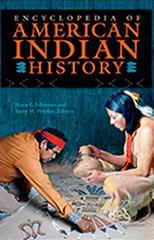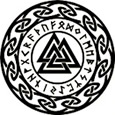
Authors : Johansen Bruce E. - Pritzker Barry M.
Title : Encyclopedia of American Indian history
Year : 2008
Link download : Johansen_Bruce_E_-_Pritzker_Barry_M_-_Encyclopedia_of_American_Indian_history.zip
Introduction. A BOOK CAN BE A TIME MACHINE, opening a window on the unquestioned judgments and assumptions of authors in other times. Many of these have been delivered with a sense of European-American self-congratulation. Consider John D. Hicks, who, in The Federal Union: A History of the United States to 1865 (1937) opens a 700-page tome with the words “The civilization that grew up in the United States . . .” implying that nothing worth the name occurred before Columbus planted European seeds here (Hicks, 1937, 1). Paragraph two begins: “America before the time of Columbus had developed no great civilizations of its own” (Hicks, 1937, 1). This text states authoritatively that the Mayas, Aztecs, and Incas could not match “the best that Europe had to offer” (Hicks, 1937, 1), despite the fact that accounts of the Cortez invasion expressed a sense of awe at the Aztecs’ capital city Tenochtitlan when they first saw it. In the same paragraph, Hicks develops reasons why he believes that Europeans surpassed America’s “primitive civilization”: “racial traits may account in part for this failure, but the importance of the environment cannot be overlooked” (Hicks, 1937, 1). No time and no people speak with a single voice, however. So while Hicks’ assumptions of racial superiority remind us of Richard Henry Pratt’s advertising slogan for the boarding schools he built (“Kill the Indian, Save the Man”) even Pratt’s and Hicks’ time were informed by other voices that asserted enduring value to Native American peoples and cultures. While Pratt’s slogan is sometimes interpreted as an endorsement of genocide in our time, to him it was friendly advice to peoples whom he assumed would die culturally as well as genetically if they held fast to cultures that he considered out of date in a modern world. Multicultural ideas that inform public discourse (as well as census reports) in our time had precedents in Pratt’s and Hicks’ time. The majority society was just not listening. Consider Walt Whitman, for example, during 1883, as Pratt was fashioning his campaign to save Indians by killing their cultures: As to our aboriginal or Indian population . . . I know it seems to be agreed that they must gradually dwindle as time rolls on, and in a few generations more leave only a reminiscence, a blank. But I am not at all clear about that. As America . . . develops, adapts, entwines, faithfully identifies its own—are we to see it cheerfully accepting using all the contributions of foreign lands from the whole outside globe—and then rejecting the only ones distinctly its own? (Moquin, 1973, 5–6). One newspaper, the Omaha World-Herald, sent a native woman, Susette LaFlesche (an Omaha), to describe the aftermath of the Wounded Knee massacre. She was married to Thomas Tibbles. Together, a decade earlier, they had roused their city of Omaha in anger over the torturous treatment suffered by the Ponca Standing Bear and his band. Exiled in Indian Territory from their homeland along the Niobrara River (in northernmost Nebraska), the Poncas had escaped and walked home, stopping in the city, their feet bleeding in the snow, so hungry that they had chewed on their moccasins. General George Crook volunteered to be the defendant in a legal case that established the Poncas’ right to return home. History is full of surprises. The same year that Hicks’ book was published, Matthew W. Stirling, chief and later director of the American Bureau of Ethnology for thirty years (1928–1958), stated in National Geographic that the Albany Plan of Union (1754) was fundamentally shaped by the Iroquois Confederacy through Benjamin Franklin (Stirling, 1937). Such an idea is hardly universally accepted, even in our time. For one, Steven Pinker, in The Blank Slate, asserted that the same idea was flimsy enough to dismiss without explanation in two words: “1960s granola” (Pinker, 2002, 298). Historically, we stand with Whitman and Stirling. The Encyclopedia of American Indian History attempts to redress assumptions that any single culture is superior to any other. American Indian voices were available to historians in the 1930s; it was, after all, a time of major Native rights assertion under the Indian Reorganization Act, but many non-Native historians seemed not to be listening. The writings of Dr. Charles A. Eastman (or, to use his Dakota name, Ohiyesa) and Luther Standing Bear were widely published, among many others. Major nineteenthcentury feminists (Elizabeth Cady Stanton and Matilda Joslyn Gage, to name two) had acknowledged their debt to Native matriarchal societies. Still, one can hardly imagine Hicks having any use for an encyclopedia entry titled “American Indian Contributions to the World.” We start with six essays, written by our coeditors and members of our editorial board, which focus on the themes that dominate particular eras in American Indian history. So, for example, if a reader wants to find out why the Trail of Tears migration happened when it did, s/he would find that context covered in the essay dealing with the period from 1800 to 1850. The late Vine Deloria, Jr. once advised non-Indian scholars to study the history of topics of contemporary importance to Native peoples, and a section of the encyclopedia addresses those issues that are prominent both in the history of Native peoples and in Native societies today. These entries range from archaeology and pre-contact Native history to topics like gaming and water rights, which are still so relevant. Subsequent sections deal with the most important events of American Indian history, aspects of Native cultures that have had ramifications in history, Native interactions with non-Indian governments, and the roles of both individuals and groups in American Indian history. One of the most important sections of the encyclopedia, the histories of particular Native nations, is absolutely vital to the stories we’re seeking to have told and deserves to be highlighted. Also, primary sources from throughout American Indian history are presented so that readers can get a flavor of how different people viewed these events as they happened. The occupancy of most of North America by Europeans on a sustained basis is less than 200 years old—four consecutive human lives then, less than three now. Thus, the importance of American Indian history to the recent history of all peoples on this continent is clear. The history is written in what we call our homeland—many of our cities, half the constituent states in the federal union that calls itself the United States, bear names that have Native roots. If there is one thing we’ve learned from trying to organize and do justice to such a vast and important subject, it is that there is no way to present this material that is perfect for everyone. Different people learn best in different ways. However, we’ve endeavored to be as clear as possible, making the large number of materials and resources as easy to locate and use as possible. An encyclopedia is not a cast-iron product, but a collection of many contributors’ work. In our case, this is a mixture of Native and non-Native voices. Selection of subject matter is subject to judgment, and interpretation, and will be reviewed—something or someone is included, someone or something else is ignored, or given short shrift. We can say only that we have done our best. Bruce E. Johansen and Barry M. Pritzker, Editors Steven L. Danver, Project Editor. ...

Palmer Michael - Hiroshima revisited
Author : Palmer Michael Title : Hiroshima revisited The evidence that napalm and mustard gas helped...














